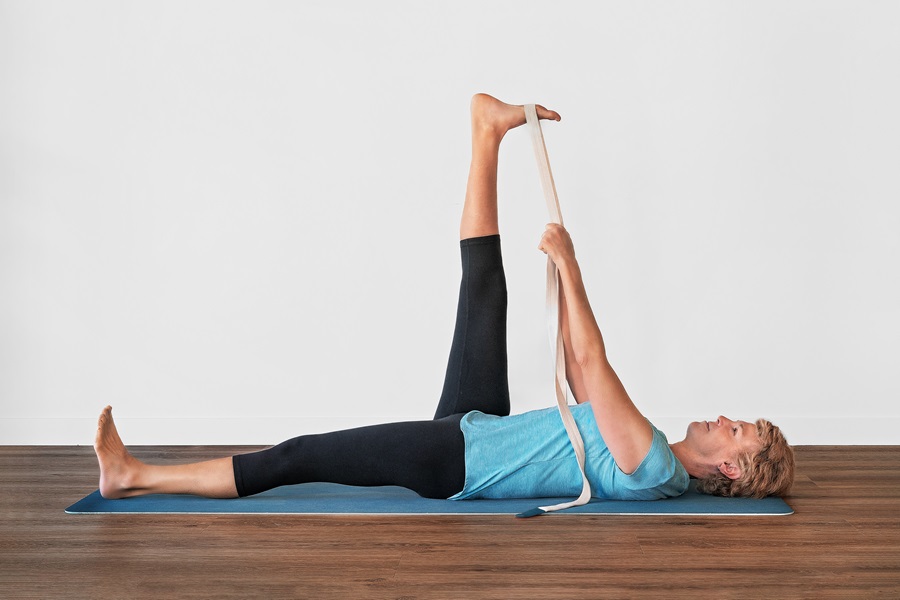If I had a nickel for every time someone has said, “I can’t do yoga because I’m not flexible,” I’d have enough for a trip to Kripalu. You do not need to deprive yourself of the soothing, calming effects of yoga on your body and mind just because you think you are too stiff. Flexibility is something you can develop over time.
While each of us has a unique bone structure and body condition that may limit our ability to open up in a particular pose, yoga allows for adaptations that give us ways to benefit from most poses.
Yoga is about optimizing the health and welfare of your body, mind, and spirit. To do that, you simply have to start where you are.
Supta Padangusthasana is an example of a pose that might seem impossible at first. Supta means supine, lying down. Padangusthasana means big toe. This is the Reclining Hand-to-Big-Toe pose.

There are many ways to experience the substantial benefits of this pose. It can be done lying on the floor, lying on a bed, or even sitting in a chair. And you can use a strap to help you reach your big toe safely — or if you don’t have a yoga strap, you can use a bathrobe tie or a long cloth belt.
Fundamentally, this pose allows you to open your hamstrings. But since everything in the body is connected, you will likely feel benefits in other places, like your back, ankles, and hips.
Start by lying on your back. You may lie on the floor with a mat or blanket as cushioning, or you may do this pose lying on your back in a bed. (I will explain the chair option after describing the supine version.)
Extend your legs straight and flex your feet. Stretch your legs long, reach your arms overhead, on the floor, and stretch them long as well; then release your arms to your sides. You are looking for a feeling of length while at the same time maintaining the natural curves in your spine. To know if you are maintaining those natural curves, try sliding your hand under the small of your back. Allow a little space there.
Now move your left hand onto your left thigh. Bend your right leg and lift your knee toward your head. Take the strap and loop it around the ball of the right foot. Most of us can’t straighten our leg while grasping the big toe. We use a prop, the strap or belt, to help us adapt the pose. From here, straighten the right leg toward the ceiling.
Think about your form for a moment. Use your left hand to keep the left leg stretched out along the floor. The left foot should be in line with the left hip and should be flexed. Both legs are engaged. Keep your body grounded by pressing the left thigh into the floor while maintaining the natural curve of your spine.
If you feel lower back pain, try keeping the left leg bent with your left foot on the floor. Another adaptation would be to put your left foot up against a wall, pressing the foot into the wall to anchor and stabilize you.
If you practice this pose regularly, you may find you can eventually straighten the left leg on the floor. Patience, persistence, and regularity will pay off — but there is no need to push it. It is likely that you will not be able to have your right leg completely straight at first. Or you may not be able to flatten the left leg on the floor. As you can see in the photo, my left thigh is above the floor. This pose for me is a work in progress.
Once you have held the pose for a few breaths on the right side, release your foot from the strap and straighten both legs along the floor. Your right leg may now feel longer than the left. Repeat the pose raising your left leg. Go back and forth, holding each side for a few breaths.
Repeat this up to three times on each side, then stretch out on the floor and see how you feel. Do you notice any difference?
If you find it hard to work from the floor or your bed, try this pose sitting in a chair. Sit up straight with both feet on the floor and the strap in hand. Loop the strap around the ball of one foot and stretch the leg out in front of you, holding the belt in both hands. Straighten the leg as much as you can and keep the foot flexed. Hold the stretch for a few breaths, then switch sides.
One of the big benefits of yoga is that it increases our body awareness. That will come as you take a few breaths after holding a pose to notice what you are feeling. Do you notice a greater sense of ease in your body? Or maybe a calmer state of mind? If not, maybe you are pushing yourself too hard as you do the pose.
Try doing less, stretching less. Pushing is not a part of yoga. The esteemed teacher B.K.S. Iyengar, who introduced yoga to the West in the 1950s, famously advised: “Nothing can be forced; receptivity is everything.” Find your edge and then back off. The edge will change with practice.



